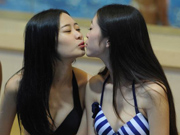Rome, August 26 - Marc Chagall's largest-ever retrospective in Italy will open on September 17 at Milan's Palazzo Reale.
The exhibit 'Marc Chagall. A retrospective 1908-1985' runs through February 1, 2015.
Over 220 masterworks from international public and private collections will be showcased at the exhibit, which will also present an unpublished autobiography of the Russian artist recently discovered in the Parisian archives of Marc and daughter Ida Chagall.
In the autobiography, Chagall (1887-1985) unveils interesting details about his life like his squabbles with Pablo Picasso, pays tribute to Claude Monet's painting, describes his admiration for Pierre Bonnard and his first touching trip to the ''Jewish land'', saying among other things that ''beyond the landscape'', he could perceive the prophets next to him. He also talks about a variety of issues ranging from the natural beauty of Nice to political and religious opinions.
The show is promoted by the city of Milan - as part of the programme 'Milan heart of Europe' - and is organized and produced by Palazzo Reale, 24 Ore Cultura of the 24 Ore Group, the Arthemisia Group and Gamm Giunti.
Claudia Zevi has curated the exhibit in cooperation with Meret Meyer with the aim of presenting a thorough insight into the artist's vast production, from his first painting 'Le petit salon', until his last monumental works dating back to the 1980s.
The exhibition documents, thanks to its vast and high-quality selection of works, Chagall's rare ability to remain true to his poetry throughout a prolific career, which makes his art immediately recognizable though he was very close to early-20th century avant-garde movements like Fauvism and Cubism.
Masterworks on show - including oil paintings, watercolours and pastels - have been loaned by leading museums including the Museum of Modern Art and Metropolitan in New York, Washington's National Gallery, the Russian Museum in Saint Petersburg and the Centre Pompidou in Paris, and hail from a total of over 50 public and private collections.
Organized chronologically, the show gives an insight into the way the artist worked his way through different cultural roots - his Jewish Hasidic upbringing, Russian heritage and western art movements which saw the light at the beginning of the 20th century in Paris - to hone his unique style.
The show opens with Chagall's first works in Russia and continues with his first stay in France and subsequent trip back home in 1921.
Chagall's autobiography, to be presented at the show, describes the moment he leaves Russia for good and starts his second exile, first in France and then, in the 1940s, in the US, where his beloved wife Bella died.
The exhibit then shows how Chagall's poetry took on the colours and relaxed atmosphere of southern France once he returned to Europe and decided to move to the Cote d'Azur.
Works including The birthday, Jew in Bright Red, The Walk, The Poet Reclining, Double Portrait, Cow with Umbrella, The Black Glove, The Madonna of the Village, and Yellow Crucifixion show how Chagall was able to communicate joy and confidence in a better world in spite of his exile and the hardships he experienced, through a unique artistic language he had honed by assimilating his three different heritages. Born to a Hasidic family in Vitebsk, Belarus, his mysticism can be traced back to his Jewish roots, while his homeland inspired his depiction of folk symbols. He drew from Dutch painter Rembrandt, as well as from contemporary avant-garde artists in Paris, though the sense of wonder towards nature can be traced back to Medieval art rather than 20th century movements.
The flowers and animals he so often portrayed enabled him to overcome a Jewish ban on depicting human figures while he transformed them, citing Russian Medieval culture, into a metaphor of a universe in which humans could finally live in peace.
 |

 Beautiful models at the fourth China-Eurasia Expo
Beautiful models at the fourth China-Eurasia Expo College students create 3D illusion Art Space in N China
College students create 3D illusion Art Space in N China In pictures: Iron-blood soldiers
In pictures: Iron-blood soldiers Urban youths turn into 'archery fans' in Chongqing
Urban youths turn into 'archery fans' in Chongqing Contestants attend closed training for Yacht Baby Contest
Contestants attend closed training for Yacht Baby Contest China's J-10 fighters
China's J-10 fighters File Photo: Diplomat Deng Xiaoping
File Photo: Diplomat Deng Xiaoping White-collar workers turn into 'Iron Ladies'
White-collar workers turn into 'Iron Ladies' Seeing double: lovely twinflowers
Seeing double: lovely twinflowers Splash wars: La Tomatina hits in Shenyang
Splash wars: La Tomatina hits in Shenyang
Day|Week|Month